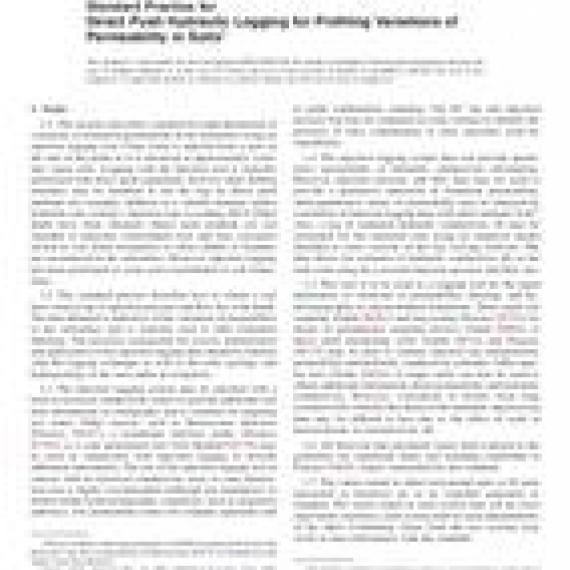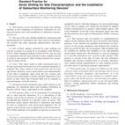No products
ASTM D8037/D8037M-16
ASTM D8037/D8037M-16 Standard Practice for Direct Push Hydraulic Logging for Profiling Variations of Permeability in Soils
standard by ASTM International, 11/15/2016
Full Description
1.1This practice describes a method for rapid delineation of variations in formation permeability in the subsurface using an injection logging tool. Clean water is injected from a port on the side of the probe as it is advanced at approximately 2cm/s into virgin soils. Logging with the injection tool is typically performed with direct push equipment, however other drilling machines may be modified to run the logs by direct push methods (for example, addition of a suitable hammer and/or hydraulic ram systems). Injection logs exceeding 100 ft [30m] depth have been obtained. Direct push methods are not intended to penetrate consolidated rock and may encounter refusal in very dense formations or when cobbles or boulders are encountered in the subsurface. However, injection logging has been performed in some semi-consolidated or soft formations.
1.2This standard practice describes how to obtain a real time vertical log of injection pressure and flow rate with depth. The data obtained is indicative of the variations of permeability in the subsurface and is typically used to infer formation lithology. The person(s) responsible for review, interpretation and application of the injection logging data should be familiar with the logging technique as well as the soils, geology and hydrogeology of the area under investigation.
1.3The injection logging system may be operated with a built in electrical conductivity sensor to provide additional real time information on stratigraphy and is essential for targeting test zones. Other sensors, such as fluorescence detectors (Practice D6187), a membrane interface probe (Practice D7352) or a cone penetration tool (Test Method D5778) may be used in conjunction with injection logging to provide additional information. The use of the injection logging tool in concert with an electrical conductivity array or cone penetration tool is highly recommended (although not mandatory) to further define hydrostratigraphic conditions, such as migration pathways, low permeability zones (for example, aquitards) and to guide confirmation sampling. The EC log and injection pressure log may be compared in some settings to identify the presence of ionic contaminants or ionic injectates used for remediation.
1.4The injection logging system does not provide quantitative permeability or hydraulic conductivity information. However, injection pressure and flow data may be used to provide a qualitative indication of formation permeability. Semi-quantitative values of permeability may be obtained by correlation of injection logging data with other methods (1-4).2 Also, a log of estimated hydraulic conductivity (5) may be calculated for the saturated zone using an empirical model included in some versions of the log viewing software. The data allows for estimates of hydraulic conductivity (K) at the inch-scale using the corrected injection pressure and flow rate.
1.5This tool is to be used as a logging tool for the rapid delineation of variations in permeability, lithology and hydrostratigraphy in unconsolidated formations. Direct push soil sampling (Guide D6282) and slug testing (Practice D7242) by means of groundwater sampling devices (Guide D6001) or direct push monitoring wells (Guide D6724 and Practice D6725) may be used to validate injection log interpretation, permeability and hydraulic conductivity estimates. Other aquifer tests (Guide D4043) in larger wells can also be used to obtain additional information about permeability and hydraulic conductivity. However, correlation of results from long screened wells with the fine detail of the hydraulic injection log data may be difficult at best due to the effect of scale in measurements of transmissivity (6).
1.6All observed and calculated values shall conform to the guidelines for significant digits and rounding established in Practice D6026, unless superseded by this standard.
1.7The values stated in either inch-pound units or SI units [presented in brackets] are to be regarded separately as standard. The values stated in each system may not be exact equivalents; therefore, each system shall be used independently of the other. Combining values from the two systems may result in non-conformance with the standard.
1.8This practice offers a set of instructions for performing one or more specific operations. This document cannot replace education or experience and should be used in conjunction with professional judgment. Not all aspects of this practice may be applicable in all circumstances. This ASTM standard is not intended to represent or replace the standard of care by which the adequacy of a given professional service must be judged, nor should this document be applied without the consideration of a projects many unique aspects. The word standard in the title means that the document has been approved through the ASTM consensus process.
1.9This standard does not purport to address all of the safety concerns, if any, associated with its use. It is the responsibility of the user of this standard to establish appropriate safety and health practices and determine the applicability of regulatory limitations prior to use.


































